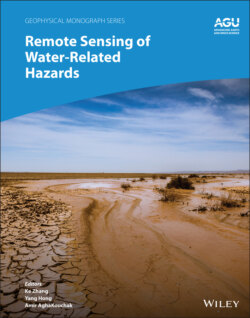Читать книгу Remote Sensing of Water-Related Hazards - Группа авторов - Страница 24
2.2. STUDY AREA AND DATASETS 2.2.1. Study Area
ОглавлениеThe evaluation of satellite precipitation products is conducted between 73°–135°E and 18–53°N in China (Figure 2.1a). The terrain is characterized by decreasing elevation from west to east (Figure 2.1b). China can be further divided into eight subregions according to topography differences and climatic conditions (Wang et al., 2018). The three typical subregions highlighted in Figure 2.1 are the Qinghai‐Tibet Plateau (TP) with extremely complex climate and topography, Xinjiang Province (XJ) with an arid climate, and the northeastern region (NE) in higher latitudes. Previous studies have shown that satellite precipitation data sets in these regions tended to have large uncertainties (Tang, Ma, et al., 2016). Besides, these regions have relatively uneven distribution of rain gauges. Gauges are much denser in the eastern and southern regions comparing to TP, XJ and NE, due to terrain and climate constraints (Figure 1a and b).
Figure 2.1 (a) Spatial distributions rain gauges in China and (b) DEM and the division of eight subregions. The Tibetan Plateau (TP), Xinjiang (XJ), and northeast China (NE) are highlighted.
Source: Based on Tang et al. (2020), Figure 01B, p 03 / Elsevier.
The area where satellite precipitation is applied to flood warning is Yunnan Province, China (Figure 2.2). This work is not implemented in the whole of China due to the limitation of hazard data availability. Yunnan Province is a low‐latitude plateau in southwest China, with an area of 390,000 square kilometers. The topography in Yunnan is relatively complex, with about 84% of the total area being mountainous. The average elevation of Yunnan is around 1980 m and most areas have elevation between 1000 and 3500 m. Another feature of Yunnan is the wide distribution of karst landforms characterized by a low water retention rate, which accounts for about 29% of Yunnan’s area. From the climate point of view, Yunnan is mainly affected by the East Asian monsoon and southwest monsoon, and about 90% of precipitation falls between May and October. Owing to the above‐mentioned factors, Yunnan experiences frequent flash flood hazards. For example, 72 people died from flash floods in 2014 in Yunnan, accounting for 22.2% of the total deaths from flash floods in China. Previous studies show that critical rainfall levels (i.e., the threshold of precipitation triggering floods) are 35–200 mm in northwestern Yunnan, 50–200 mm in southwestern Yunnan, and 100–300 mm in eastern Yunnan.
